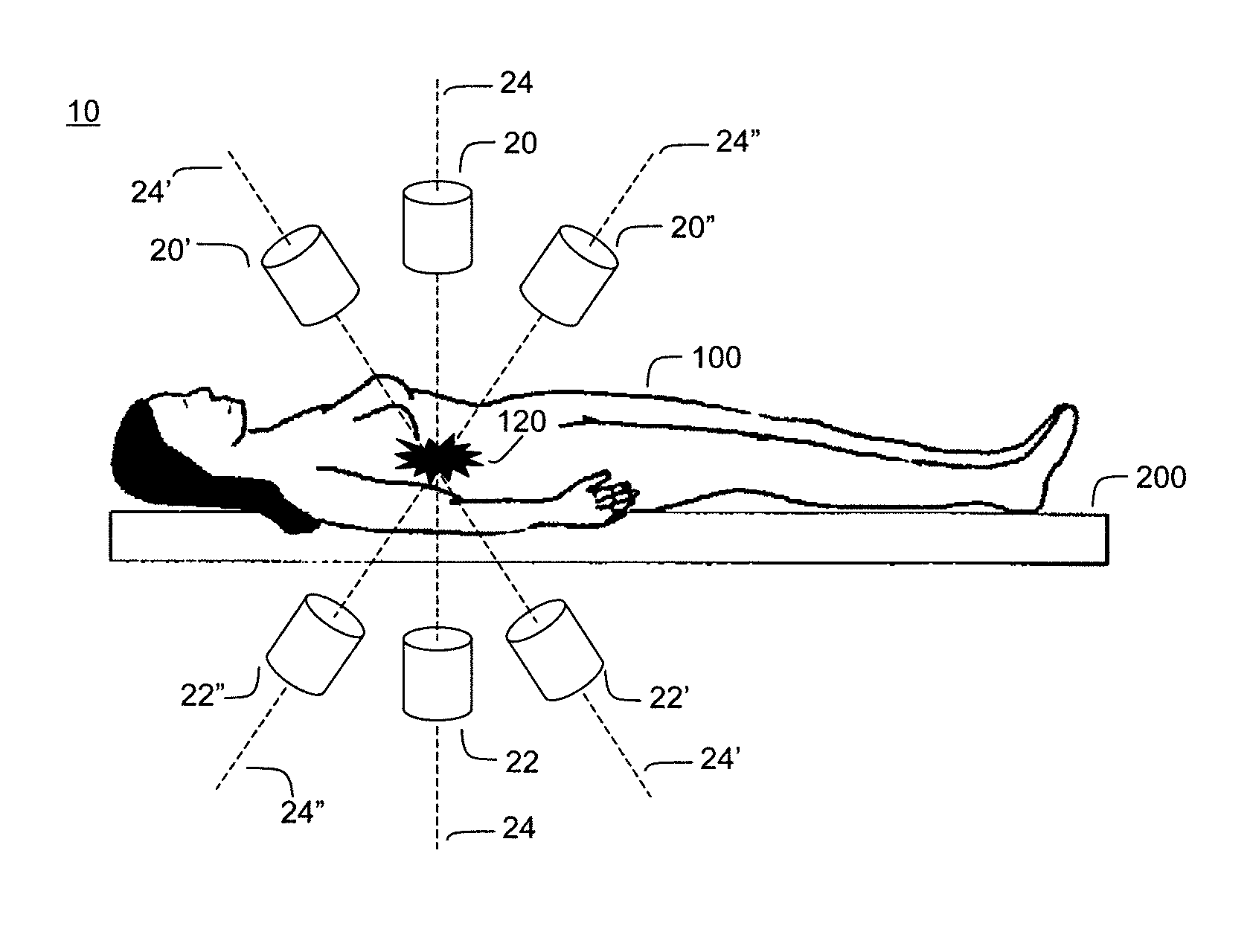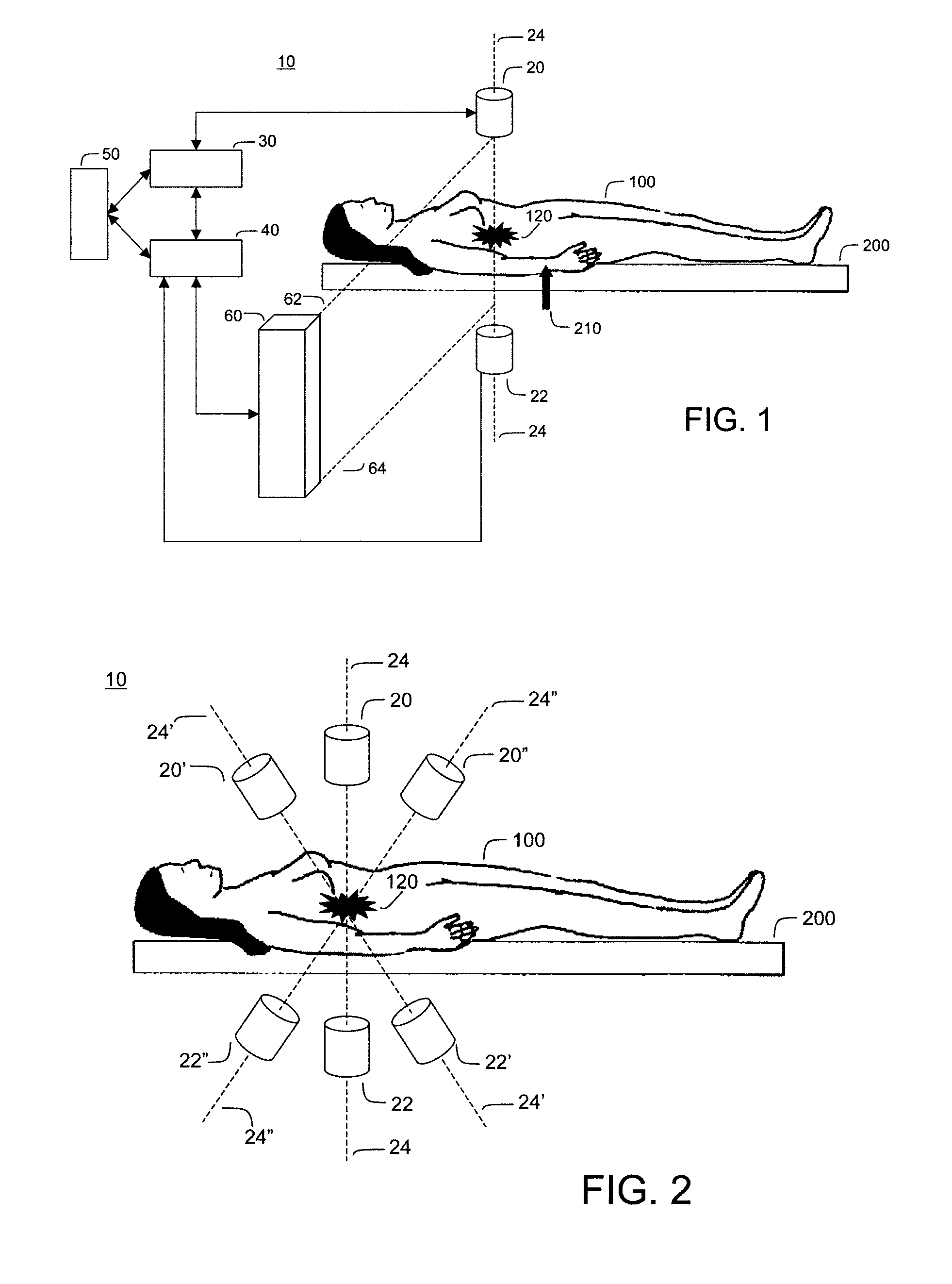Methods and Systems for Magnetic Focusing of Therapeutic, Diagnostic or Prophylactic Agents to Deep Targets
a technology of magnetic focusing and therapeutics, applied in the field of targeted magnetic therapeutic systems and methods, can solve the problems of limited success of radiation therapy, ineffective delivery of tumor cells, and inoperable tumors, and achieve the effect of measuring the effectiveness of focusing
- Summary
- Abstract
- Description
- Claims
- Application Information
AI Technical Summary
Benefits of technology
Problems solved by technology
Method used
Image
Examples
example 1
Focusing of a Ferrofluid in Air
[0120]Three-dimensional focusing of magnetizable particles in blood was modeled using a ferrofluid in air. A droplet of ferrofluid was focused to a target 1 cm away from an electromagnet using infrared sensing and electromagnetic feedback control in air, using a dynamic 0.02 Tesla magnetic field.
[0121]Large (5-8 mm) drops of magnetic liquid were suspended against gravity using an actively controlled magnetic field gradient. The drop was freely suspended in air, but its equilibrium shape depended mainly on the value of the magnetic field, with a small correction for the influence of the magnetic gradient across the dimension of the drop. The dynamics of the ferrofluid were described by Equation 1 and by surface tension forces on the droplet. Surface tension was ignored and the control algorithm was designed by shaping the applied magnetic field strength H (equivalently magnetic field B). According to Equation 3, it is not possible to have a magnetic fie...
example 2
Saddle Motion Control at Blood Vessel Walls
[0126]The methods used to focus the ferrofluid in air, will be applied to achieving the same type of focusing in a complex blood vasculature geometry, in the presence of large perturbing forces from pulsatile blood flow.
[0127]FIG. 3 illustrates the saddle motion control of ferrofluid in a blood vasculature network. The magnetic field is strongest along the magnet axis 24 and the ferrofluid will flow to this axis along the inside of blood vessel walls. Once near the axis, the particles will flow toward the nearest or strongest magnet. By varying magnet strength and positioning the saddle on either side of the majority of the ferrofluid, the ferrofluid can be shuttled between magnets to focus, on average, to the tumor location 120.
[0128]Focusing in the two dimensions perpendicular to the axis between the magnets is passive: the highest magnetic field is along the axis and so the magnetic forces point in toward the centerline. These passive fo...
example 3
Electromagnet Control and Sensing
[0130]The ability to control and sense magnetizable nanoparticles in a ferrofluid at distances greater than 30 cm will be confirmed via the following procedure. The required stronger (˜1.5 Tesla) magnets will be custom made from microbore copper piping (to allow in-situ water cooling) wound onto an appropriate core. The magnets will be driven by high-quality high-current kW power suppliers and amplifiers. A quiescent blood-mimic fluid such as that described by K. V. Ramnarine et al. (1998) Ultrasound in Medicine & Biology 24:451-459 (85% distilled water, 10% glycerol, 5% other additives) will be inside a clear 0.5 m on a side cubic container placed between sets of electromagnets. More than one magnet is needed to combat diffusion and buoyancy forces. A commercially available ferrofluid from Chemicell (Berlin, Germany) will be used that is composed of 250 nm diameter magnetizable particles.
[0131]Two, then six electromagnets, spaced 0.6 m apart, will b...
PUM
 Login to View More
Login to View More Abstract
Description
Claims
Application Information
 Login to View More
Login to View More - R&D
- Intellectual Property
- Life Sciences
- Materials
- Tech Scout
- Unparalleled Data Quality
- Higher Quality Content
- 60% Fewer Hallucinations
Browse by: Latest US Patents, China's latest patents, Technical Efficacy Thesaurus, Application Domain, Technology Topic, Popular Technical Reports.
© 2025 PatSnap. All rights reserved.Legal|Privacy policy|Modern Slavery Act Transparency Statement|Sitemap|About US| Contact US: help@patsnap.com



